Wider Professional Practice and Development Report for Bexley College
VerifiedAdded on 2020/06/06
|13
|4684
|520
Report
AI Summary
This report provides a comprehensive overview of professional practice and development within the context of education and training, specifically focusing on Bexley College. The report begins by defining professionalism and dual professionalism, reflecting on how personal values influence practice. It then analyzes the impact of social, political, and economic factors on education policies, as well as the influence of current educational policies on curriculum and practice. The roles of stakeholders and external bodies are examined, including their impact on organizations and curriculum design. Furthermore, the report discusses the importance of partnerships with employers and stakeholders, and assesses the quality improvement and assurance arrangements of the organization. It evaluates a learning program, considering areas for improvement based on the outcomes of the evaluation. The report covers key aspects of policies, codes of practice, and guidelines, and analyzes the impact of organizational requirements on curriculum practice within the author's area of specialization. The report emphasizes the importance of stakeholders and external bodies on curriculum design, delivery and assessment in own area of specialism, quality improvement, and quality assurance in the field of education and training. It highlights the importance of a professional approach in the education system. The report concludes with recommendations for improving the learning program and overall professional practice. The report provides insights into the practical application of theoretical concepts within the educational setting, which is very helpful for students.
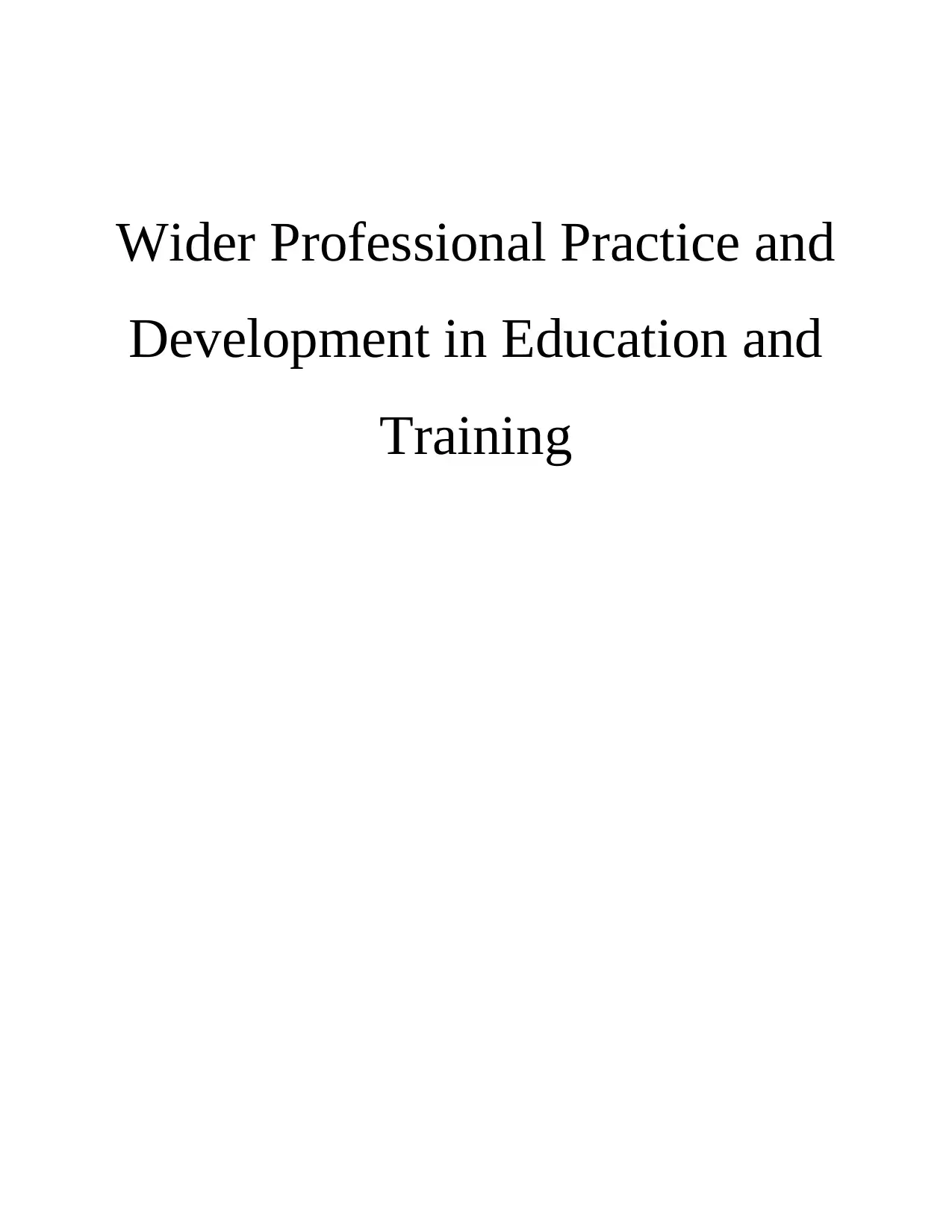
Wider Professional Practice and
Development in Education and
Training
Development in Education and
Training
Paraphrase This Document
Need a fresh take? Get an instant paraphrase of this document with our AI Paraphraser
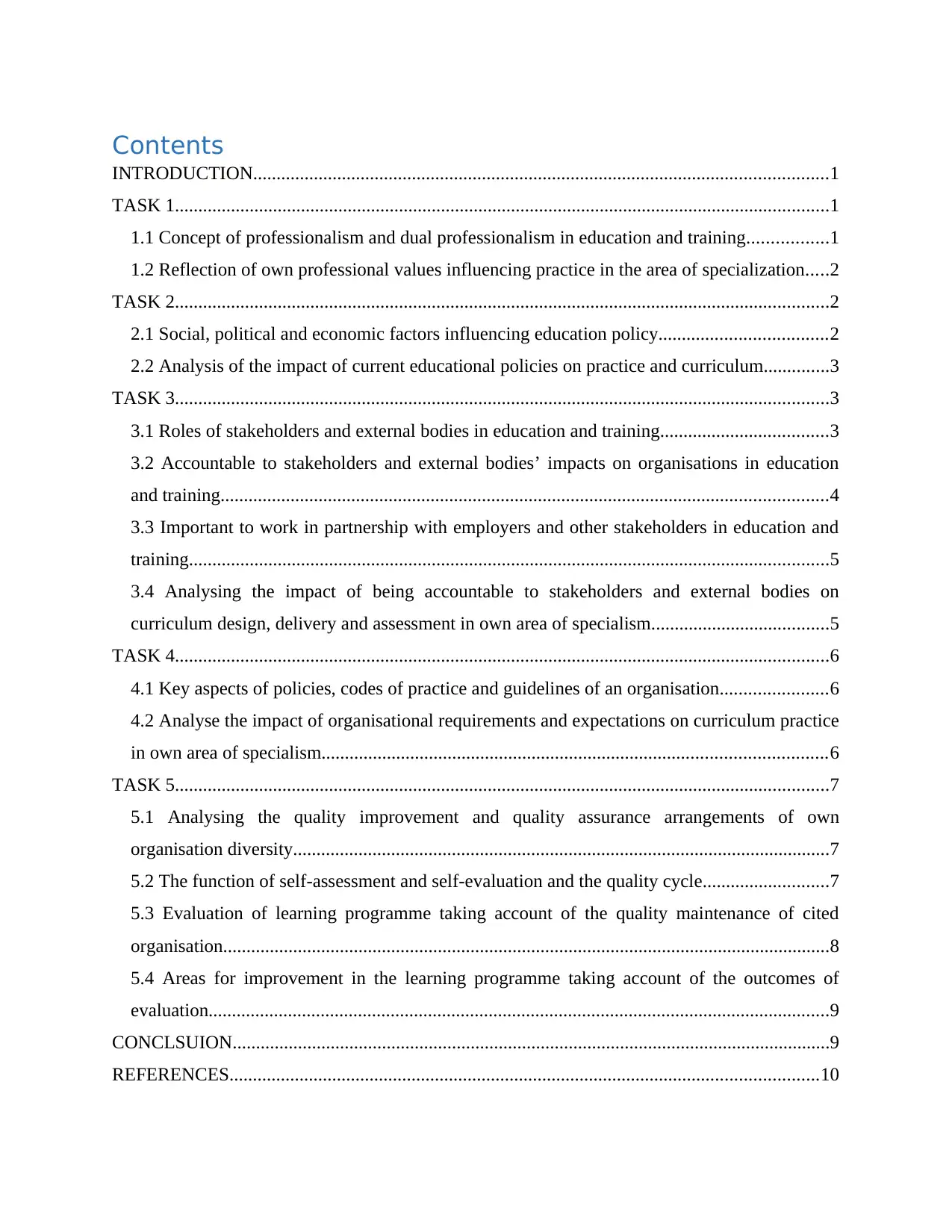
Contents
INTRODUCTION...........................................................................................................................1
TASK 1............................................................................................................................................1
1.1 Concept of professionalism and dual professionalism in education and training.................1
1.2 Reflection of own professional values influencing practice in the area of specialization.....2
TASK 2............................................................................................................................................2
2.1 Social, political and economic factors influencing education policy....................................2
2.2 Analysis of the impact of current educational policies on practice and curriculum..............3
TASK 3............................................................................................................................................3
3.1 Roles of stakeholders and external bodies in education and training....................................3
3.2 Accountable to stakeholders and external bodies’ impacts on organisations in education
and training..................................................................................................................................4
3.3 Important to work in partnership with employers and other stakeholders in education and
training.........................................................................................................................................5
3.4 Analysing the impact of being accountable to stakeholders and external bodies on
curriculum design, delivery and assessment in own area of specialism......................................5
TASK 4............................................................................................................................................6
4.1 Key aspects of policies, codes of practice and guidelines of an organisation.......................6
4.2 Analyse the impact of organisational requirements and expectations on curriculum practice
in own area of specialism............................................................................................................6
TASK 5............................................................................................................................................7
5.1 Analysing the quality improvement and quality assurance arrangements of own
organisation diversity...................................................................................................................7
5.2 The function of self-assessment and self-evaluation and the quality cycle...........................7
5.3 Evaluation of learning programme taking account of the quality maintenance of cited
organisation..................................................................................................................................8
5.4 Areas for improvement in the learning programme taking account of the outcomes of
evaluation.....................................................................................................................................9
CONCLSUION................................................................................................................................9
REFERENCES..............................................................................................................................10
INTRODUCTION...........................................................................................................................1
TASK 1............................................................................................................................................1
1.1 Concept of professionalism and dual professionalism in education and training.................1
1.2 Reflection of own professional values influencing practice in the area of specialization.....2
TASK 2............................................................................................................................................2
2.1 Social, political and economic factors influencing education policy....................................2
2.2 Analysis of the impact of current educational policies on practice and curriculum..............3
TASK 3............................................................................................................................................3
3.1 Roles of stakeholders and external bodies in education and training....................................3
3.2 Accountable to stakeholders and external bodies’ impacts on organisations in education
and training..................................................................................................................................4
3.3 Important to work in partnership with employers and other stakeholders in education and
training.........................................................................................................................................5
3.4 Analysing the impact of being accountable to stakeholders and external bodies on
curriculum design, delivery and assessment in own area of specialism......................................5
TASK 4............................................................................................................................................6
4.1 Key aspects of policies, codes of practice and guidelines of an organisation.......................6
4.2 Analyse the impact of organisational requirements and expectations on curriculum practice
in own area of specialism............................................................................................................6
TASK 5............................................................................................................................................7
5.1 Analysing the quality improvement and quality assurance arrangements of own
organisation diversity...................................................................................................................7
5.2 The function of self-assessment and self-evaluation and the quality cycle...........................7
5.3 Evaluation of learning programme taking account of the quality maintenance of cited
organisation..................................................................................................................................8
5.4 Areas for improvement in the learning programme taking account of the outcomes of
evaluation.....................................................................................................................................9
CONCLSUION................................................................................................................................9
REFERENCES..............................................................................................................................10
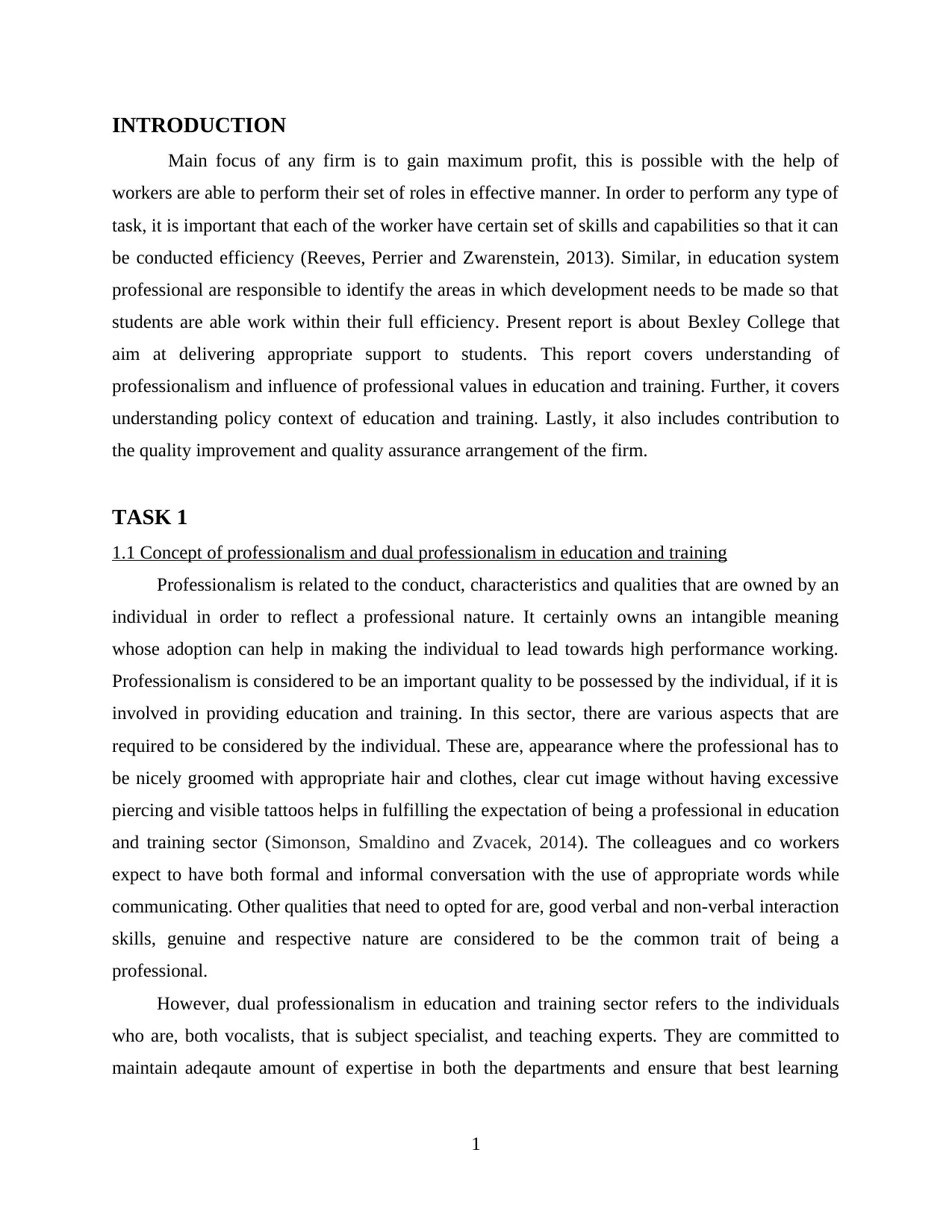
INTRODUCTION
Main focus of any firm is to gain maximum profit, this is possible with the help of
workers are able to perform their set of roles in effective manner. In order to perform any type of
task, it is important that each of the worker have certain set of skills and capabilities so that it can
be conducted efficiency (Reeves, Perrier and Zwarenstein, 2013). Similar, in education system
professional are responsible to identify the areas in which development needs to be made so that
students are able work within their full efficiency. Present report is about Bexley College that
aim at delivering appropriate support to students. This report covers understanding of
professionalism and influence of professional values in education and training. Further, it covers
understanding policy context of education and training. Lastly, it also includes contribution to
the quality improvement and quality assurance arrangement of the firm.
TASK 1
1.1 Concept of professionalism and dual professionalism in education and training
Professionalism is related to the conduct, characteristics and qualities that are owned by an
individual in order to reflect a professional nature. It certainly owns an intangible meaning
whose adoption can help in making the individual to lead towards high performance working.
Professionalism is considered to be an important quality to be possessed by the individual, if it is
involved in providing education and training. In this sector, there are various aspects that are
required to be considered by the individual. These are, appearance where the professional has to
be nicely groomed with appropriate hair and clothes, clear cut image without having excessive
piercing and visible tattoos helps in fulfilling the expectation of being a professional in education
and training sector (Simonson, Smaldino and Zvacek, 2014). The colleagues and co workers
expect to have both formal and informal conversation with the use of appropriate words while
communicating. Other qualities that need to opted for are, good verbal and non-verbal interaction
skills, genuine and respective nature are considered to be the common trait of being a
professional.
However, dual professionalism in education and training sector refers to the individuals
who are, both vocalists, that is subject specialist, and teaching experts. They are committed to
maintain adeqaute amount of expertise in both the departments and ensure that best learning
1
Main focus of any firm is to gain maximum profit, this is possible with the help of
workers are able to perform their set of roles in effective manner. In order to perform any type of
task, it is important that each of the worker have certain set of skills and capabilities so that it can
be conducted efficiency (Reeves, Perrier and Zwarenstein, 2013). Similar, in education system
professional are responsible to identify the areas in which development needs to be made so that
students are able work within their full efficiency. Present report is about Bexley College that
aim at delivering appropriate support to students. This report covers understanding of
professionalism and influence of professional values in education and training. Further, it covers
understanding policy context of education and training. Lastly, it also includes contribution to
the quality improvement and quality assurance arrangement of the firm.
TASK 1
1.1 Concept of professionalism and dual professionalism in education and training
Professionalism is related to the conduct, characteristics and qualities that are owned by an
individual in order to reflect a professional nature. It certainly owns an intangible meaning
whose adoption can help in making the individual to lead towards high performance working.
Professionalism is considered to be an important quality to be possessed by the individual, if it is
involved in providing education and training. In this sector, there are various aspects that are
required to be considered by the individual. These are, appearance where the professional has to
be nicely groomed with appropriate hair and clothes, clear cut image without having excessive
piercing and visible tattoos helps in fulfilling the expectation of being a professional in education
and training sector (Simonson, Smaldino and Zvacek, 2014). The colleagues and co workers
expect to have both formal and informal conversation with the use of appropriate words while
communicating. Other qualities that need to opted for are, good verbal and non-verbal interaction
skills, genuine and respective nature are considered to be the common trait of being a
professional.
However, dual professionalism in education and training sector refers to the individuals
who are, both vocalists, that is subject specialist, and teaching experts. They are committed to
maintain adeqaute amount of expertise in both the departments and ensure that best learning
1
⊘ This is a preview!⊘
Do you want full access?
Subscribe today to unlock all pages.

Trusted by 1+ million students worldwide
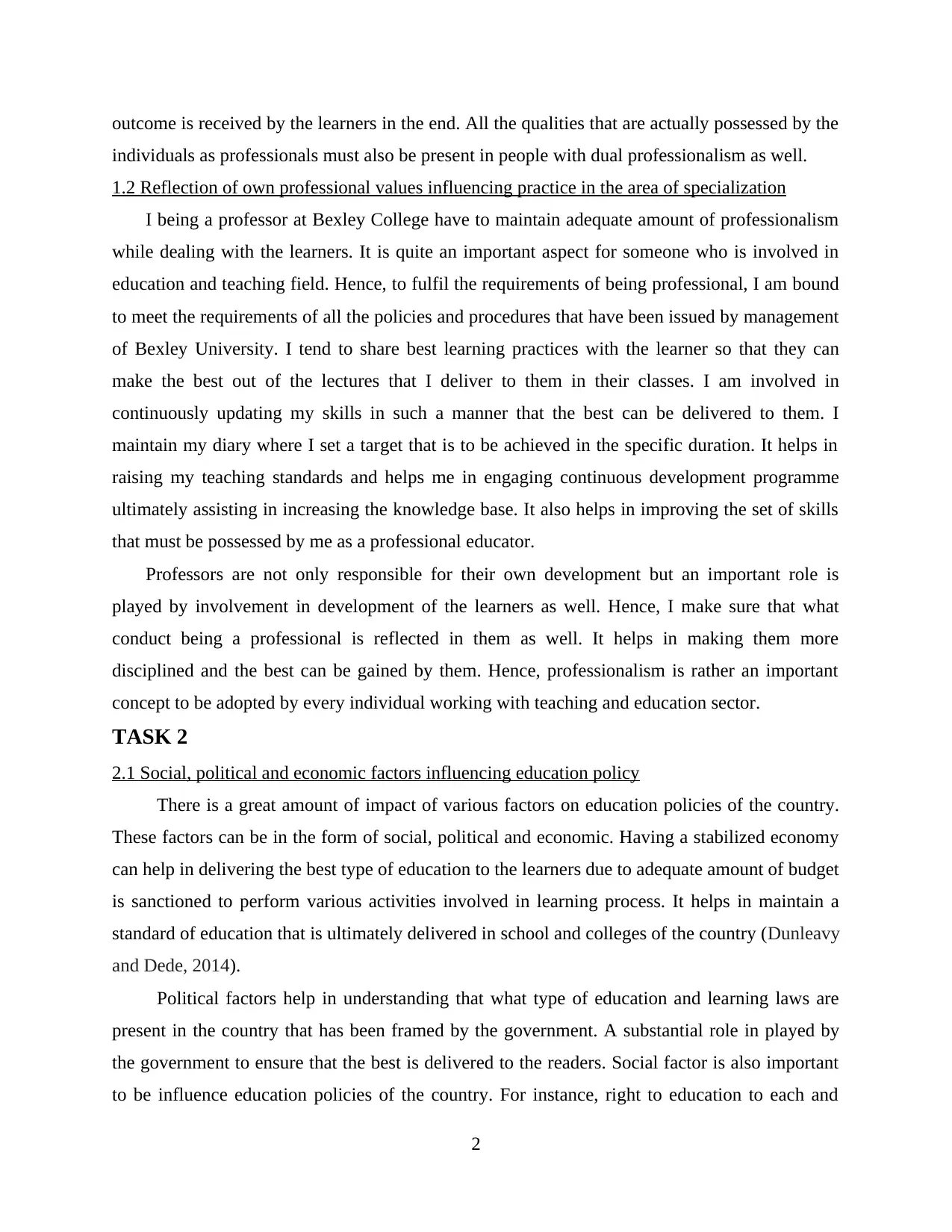
outcome is received by the learners in the end. All the qualities that are actually possessed by the
individuals as professionals must also be present in people with dual professionalism as well.
1.2 Reflection of own professional values influencing practice in the area of specialization
I being a professor at Bexley College have to maintain adequate amount of professionalism
while dealing with the learners. It is quite an important aspect for someone who is involved in
education and teaching field. Hence, to fulfil the requirements of being professional, I am bound
to meet the requirements of all the policies and procedures that have been issued by management
of Bexley University. I tend to share best learning practices with the learner so that they can
make the best out of the lectures that I deliver to them in their classes. I am involved in
continuously updating my skills in such a manner that the best can be delivered to them. I
maintain my diary where I set a target that is to be achieved in the specific duration. It helps in
raising my teaching standards and helps me in engaging continuous development programme
ultimately assisting in increasing the knowledge base. It also helps in improving the set of skills
that must be possessed by me as a professional educator.
Professors are not only responsible for their own development but an important role is
played by involvement in development of the learners as well. Hence, I make sure that what
conduct being a professional is reflected in them as well. It helps in making them more
disciplined and the best can be gained by them. Hence, professionalism is rather an important
concept to be adopted by every individual working with teaching and education sector.
TASK 2
2.1 Social, political and economic factors influencing education policy
There is a great amount of impact of various factors on education policies of the country.
These factors can be in the form of social, political and economic. Having a stabilized economy
can help in delivering the best type of education to the learners due to adequate amount of budget
is sanctioned to perform various activities involved in learning process. It helps in maintain a
standard of education that is ultimately delivered in school and colleges of the country (Dunleavy
and Dede, 2014).
Political factors help in understanding that what type of education and learning laws are
present in the country that has been framed by the government. A substantial role in played by
the government to ensure that the best is delivered to the readers. Social factor is also important
to be influence education policies of the country. For instance, right to education to each and
2
individuals as professionals must also be present in people with dual professionalism as well.
1.2 Reflection of own professional values influencing practice in the area of specialization
I being a professor at Bexley College have to maintain adequate amount of professionalism
while dealing with the learners. It is quite an important aspect for someone who is involved in
education and teaching field. Hence, to fulfil the requirements of being professional, I am bound
to meet the requirements of all the policies and procedures that have been issued by management
of Bexley University. I tend to share best learning practices with the learner so that they can
make the best out of the lectures that I deliver to them in their classes. I am involved in
continuously updating my skills in such a manner that the best can be delivered to them. I
maintain my diary where I set a target that is to be achieved in the specific duration. It helps in
raising my teaching standards and helps me in engaging continuous development programme
ultimately assisting in increasing the knowledge base. It also helps in improving the set of skills
that must be possessed by me as a professional educator.
Professors are not only responsible for their own development but an important role is
played by involvement in development of the learners as well. Hence, I make sure that what
conduct being a professional is reflected in them as well. It helps in making them more
disciplined and the best can be gained by them. Hence, professionalism is rather an important
concept to be adopted by every individual working with teaching and education sector.
TASK 2
2.1 Social, political and economic factors influencing education policy
There is a great amount of impact of various factors on education policies of the country.
These factors can be in the form of social, political and economic. Having a stabilized economy
can help in delivering the best type of education to the learners due to adequate amount of budget
is sanctioned to perform various activities involved in learning process. It helps in maintain a
standard of education that is ultimately delivered in school and colleges of the country (Dunleavy
and Dede, 2014).
Political factors help in understanding that what type of education and learning laws are
present in the country that has been framed by the government. A substantial role in played by
the government to ensure that the best is delivered to the readers. Social factor is also important
to be influence education policies of the country. For instance, right to education to each and
2
Paraphrase This Document
Need a fresh take? Get an instant paraphrase of this document with our AI Paraphraser
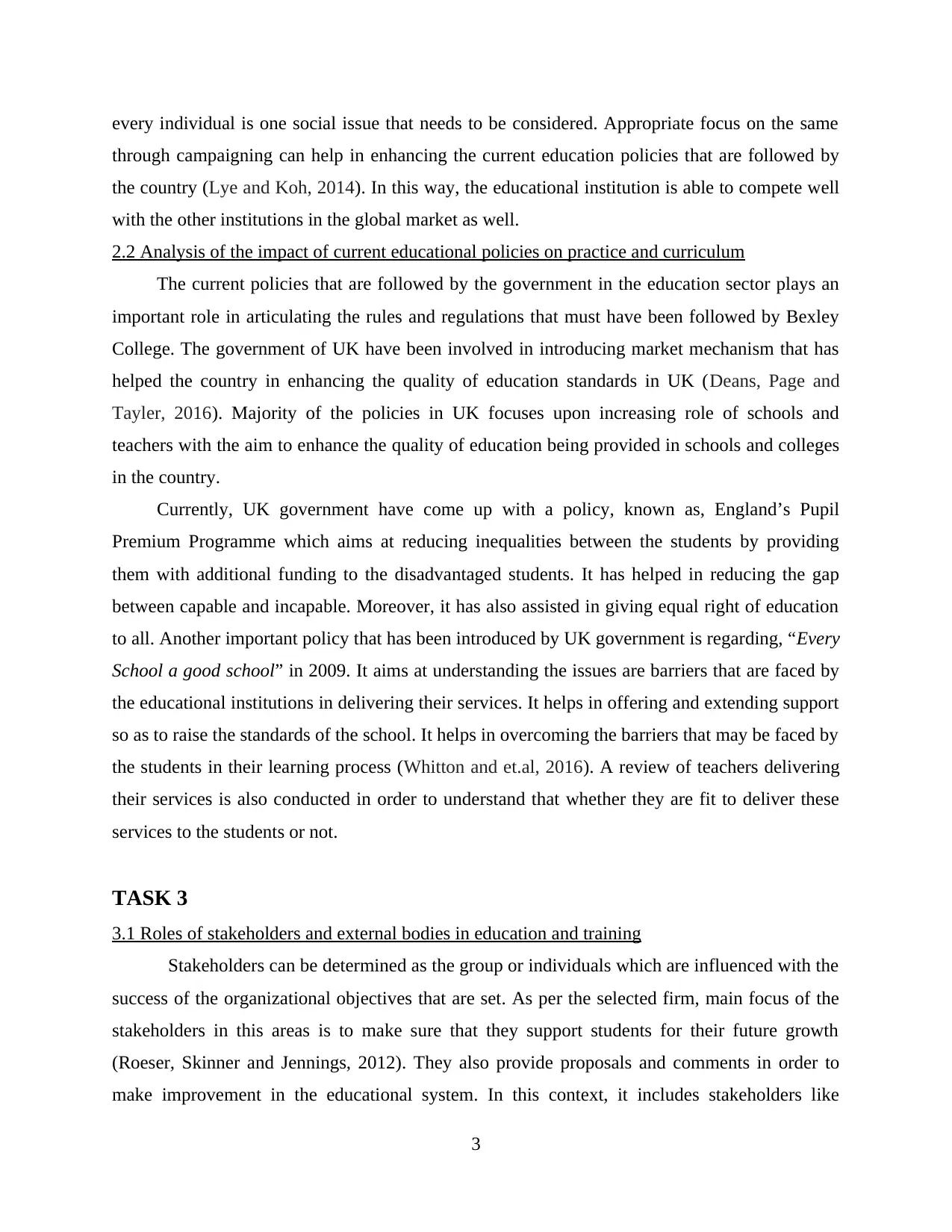
every individual is one social issue that needs to be considered. Appropriate focus on the same
through campaigning can help in enhancing the current education policies that are followed by
the country (Lye and Koh, 2014). In this way, the educational institution is able to compete well
with the other institutions in the global market as well.
2.2 Analysis of the impact of current educational policies on practice and curriculum
The current policies that are followed by the government in the education sector plays an
important role in articulating the rules and regulations that must have been followed by Bexley
College. The government of UK have been involved in introducing market mechanism that has
helped the country in enhancing the quality of education standards in UK (Deans, Page and
Tayler, 2016). Majority of the policies in UK focuses upon increasing role of schools and
teachers with the aim to enhance the quality of education being provided in schools and colleges
in the country.
Currently, UK government have come up with a policy, known as, England’s Pupil
Premium Programme which aims at reducing inequalities between the students by providing
them with additional funding to the disadvantaged students. It has helped in reducing the gap
between capable and incapable. Moreover, it has also assisted in giving equal right of education
to all. Another important policy that has been introduced by UK government is regarding, “Every
School a good school” in 2009. It aims at understanding the issues are barriers that are faced by
the educational institutions in delivering their services. It helps in offering and extending support
so as to raise the standards of the school. It helps in overcoming the barriers that may be faced by
the students in their learning process (Whitton and et.al, 2016). A review of teachers delivering
their services is also conducted in order to understand that whether they are fit to deliver these
services to the students or not.
TASK 3
3.1 Roles of stakeholders and external bodies in education and training
Stakeholders can be determined as the group or individuals which are influenced with the
success of the organizational objectives that are set. As per the selected firm, main focus of the
stakeholders in this areas is to make sure that they support students for their future growth
(Roeser, Skinner and Jennings, 2012). They also provide proposals and comments in order to
make improvement in the educational system. In this context, it includes stakeholders like
3
through campaigning can help in enhancing the current education policies that are followed by
the country (Lye and Koh, 2014). In this way, the educational institution is able to compete well
with the other institutions in the global market as well.
2.2 Analysis of the impact of current educational policies on practice and curriculum
The current policies that are followed by the government in the education sector plays an
important role in articulating the rules and regulations that must have been followed by Bexley
College. The government of UK have been involved in introducing market mechanism that has
helped the country in enhancing the quality of education standards in UK (Deans, Page and
Tayler, 2016). Majority of the policies in UK focuses upon increasing role of schools and
teachers with the aim to enhance the quality of education being provided in schools and colleges
in the country.
Currently, UK government have come up with a policy, known as, England’s Pupil
Premium Programme which aims at reducing inequalities between the students by providing
them with additional funding to the disadvantaged students. It has helped in reducing the gap
between capable and incapable. Moreover, it has also assisted in giving equal right of education
to all. Another important policy that has been introduced by UK government is regarding, “Every
School a good school” in 2009. It aims at understanding the issues are barriers that are faced by
the educational institutions in delivering their services. It helps in offering and extending support
so as to raise the standards of the school. It helps in overcoming the barriers that may be faced by
the students in their learning process (Whitton and et.al, 2016). A review of teachers delivering
their services is also conducted in order to understand that whether they are fit to deliver these
services to the students or not.
TASK 3
3.1 Roles of stakeholders and external bodies in education and training
Stakeholders can be determined as the group or individuals which are influenced with the
success of the organizational objectives that are set. As per the selected firm, main focus of the
stakeholders in this areas is to make sure that they support students for their future growth
(Roeser, Skinner and Jennings, 2012). They also provide proposals and comments in order to
make improvement in the educational system. In this context, it includes stakeholders like
3
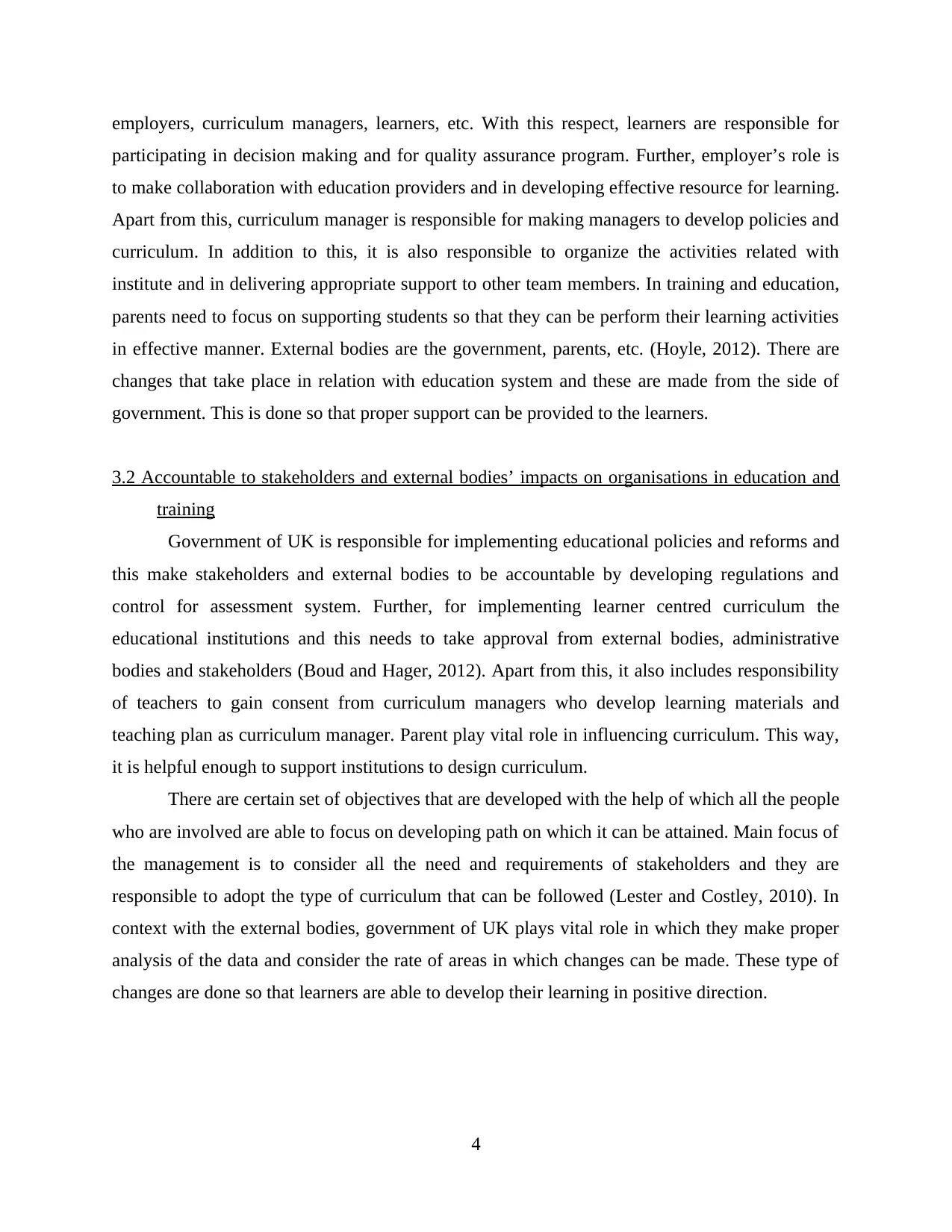
employers, curriculum managers, learners, etc. With this respect, learners are responsible for
participating in decision making and for quality assurance program. Further, employer’s role is
to make collaboration with education providers and in developing effective resource for learning.
Apart from this, curriculum manager is responsible for making managers to develop policies and
curriculum. In addition to this, it is also responsible to organize the activities related with
institute and in delivering appropriate support to other team members. In training and education,
parents need to focus on supporting students so that they can be perform their learning activities
in effective manner. External bodies are the government, parents, etc. (Hoyle, 2012). There are
changes that take place in relation with education system and these are made from the side of
government. This is done so that proper support can be provided to the learners.
3.2 Accountable to stakeholders and external bodies’ impacts on organisations in education and
training
Government of UK is responsible for implementing educational policies and reforms and
this make stakeholders and external bodies to be accountable by developing regulations and
control for assessment system. Further, for implementing learner centred curriculum the
educational institutions and this needs to take approval from external bodies, administrative
bodies and stakeholders (Boud and Hager, 2012). Apart from this, it also includes responsibility
of teachers to gain consent from curriculum managers who develop learning materials and
teaching plan as curriculum manager. Parent play vital role in influencing curriculum. This way,
it is helpful enough to support institutions to design curriculum.
There are certain set of objectives that are developed with the help of which all the people
who are involved are able to focus on developing path on which it can be attained. Main focus of
the management is to consider all the need and requirements of stakeholders and they are
responsible to adopt the type of curriculum that can be followed (Lester and Costley, 2010). In
context with the external bodies, government of UK plays vital role in which they make proper
analysis of the data and consider the rate of areas in which changes can be made. These type of
changes are done so that learners are able to develop their learning in positive direction.
4
participating in decision making and for quality assurance program. Further, employer’s role is
to make collaboration with education providers and in developing effective resource for learning.
Apart from this, curriculum manager is responsible for making managers to develop policies and
curriculum. In addition to this, it is also responsible to organize the activities related with
institute and in delivering appropriate support to other team members. In training and education,
parents need to focus on supporting students so that they can be perform their learning activities
in effective manner. External bodies are the government, parents, etc. (Hoyle, 2012). There are
changes that take place in relation with education system and these are made from the side of
government. This is done so that proper support can be provided to the learners.
3.2 Accountable to stakeholders and external bodies’ impacts on organisations in education and
training
Government of UK is responsible for implementing educational policies and reforms and
this make stakeholders and external bodies to be accountable by developing regulations and
control for assessment system. Further, for implementing learner centred curriculum the
educational institutions and this needs to take approval from external bodies, administrative
bodies and stakeholders (Boud and Hager, 2012). Apart from this, it also includes responsibility
of teachers to gain consent from curriculum managers who develop learning materials and
teaching plan as curriculum manager. Parent play vital role in influencing curriculum. This way,
it is helpful enough to support institutions to design curriculum.
There are certain set of objectives that are developed with the help of which all the people
who are involved are able to focus on developing path on which it can be attained. Main focus of
the management is to consider all the need and requirements of stakeholders and they are
responsible to adopt the type of curriculum that can be followed (Lester and Costley, 2010). In
context with the external bodies, government of UK plays vital role in which they make proper
analysis of the data and consider the rate of areas in which changes can be made. These type of
changes are done so that learners are able to develop their learning in positive direction.
4
⊘ This is a preview!⊘
Do you want full access?
Subscribe today to unlock all pages.

Trusted by 1+ million students worldwide
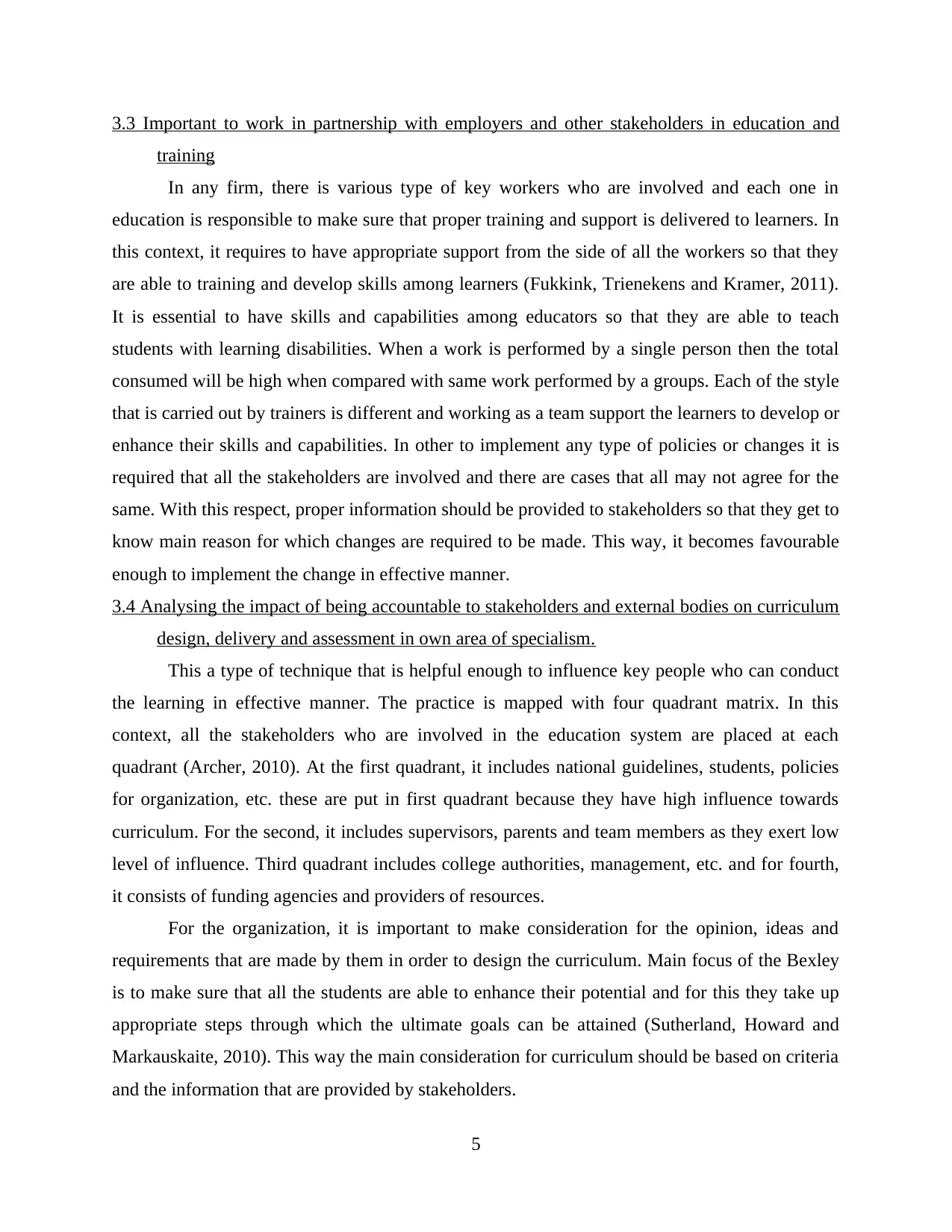
3.3 Important to work in partnership with employers and other stakeholders in education and
training
In any firm, there is various type of key workers who are involved and each one in
education is responsible to make sure that proper training and support is delivered to learners. In
this context, it requires to have appropriate support from the side of all the workers so that they
are able to training and develop skills among learners (Fukkink, Trienekens and Kramer, 2011).
It is essential to have skills and capabilities among educators so that they are able to teach
students with learning disabilities. When a work is performed by a single person then the total
consumed will be high when compared with same work performed by a groups. Each of the style
that is carried out by trainers is different and working as a team support the learners to develop or
enhance their skills and capabilities. In other to implement any type of policies or changes it is
required that all the stakeholders are involved and there are cases that all may not agree for the
same. With this respect, proper information should be provided to stakeholders so that they get to
know main reason for which changes are required to be made. This way, it becomes favourable
enough to implement the change in effective manner.
3.4 Analysing the impact of being accountable to stakeholders and external bodies on curriculum
design, delivery and assessment in own area of specialism.
This a type of technique that is helpful enough to influence key people who can conduct
the learning in effective manner. The practice is mapped with four quadrant matrix. In this
context, all the stakeholders who are involved in the education system are placed at each
quadrant (Archer, 2010). At the first quadrant, it includes national guidelines, students, policies
for organization, etc. these are put in first quadrant because they have high influence towards
curriculum. For the second, it includes supervisors, parents and team members as they exert low
level of influence. Third quadrant includes college authorities, management, etc. and for fourth,
it consists of funding agencies and providers of resources.
For the organization, it is important to make consideration for the opinion, ideas and
requirements that are made by them in order to design the curriculum. Main focus of the Bexley
is to make sure that all the students are able to enhance their potential and for this they take up
appropriate steps through which the ultimate goals can be attained (Sutherland, Howard and
Markauskaite, 2010). This way the main consideration for curriculum should be based on criteria
and the information that are provided by stakeholders.
5
training
In any firm, there is various type of key workers who are involved and each one in
education is responsible to make sure that proper training and support is delivered to learners. In
this context, it requires to have appropriate support from the side of all the workers so that they
are able to training and develop skills among learners (Fukkink, Trienekens and Kramer, 2011).
It is essential to have skills and capabilities among educators so that they are able to teach
students with learning disabilities. When a work is performed by a single person then the total
consumed will be high when compared with same work performed by a groups. Each of the style
that is carried out by trainers is different and working as a team support the learners to develop or
enhance their skills and capabilities. In other to implement any type of policies or changes it is
required that all the stakeholders are involved and there are cases that all may not agree for the
same. With this respect, proper information should be provided to stakeholders so that they get to
know main reason for which changes are required to be made. This way, it becomes favourable
enough to implement the change in effective manner.
3.4 Analysing the impact of being accountable to stakeholders and external bodies on curriculum
design, delivery and assessment in own area of specialism.
This a type of technique that is helpful enough to influence key people who can conduct
the learning in effective manner. The practice is mapped with four quadrant matrix. In this
context, all the stakeholders who are involved in the education system are placed at each
quadrant (Archer, 2010). At the first quadrant, it includes national guidelines, students, policies
for organization, etc. these are put in first quadrant because they have high influence towards
curriculum. For the second, it includes supervisors, parents and team members as they exert low
level of influence. Third quadrant includes college authorities, management, etc. and for fourth,
it consists of funding agencies and providers of resources.
For the organization, it is important to make consideration for the opinion, ideas and
requirements that are made by them in order to design the curriculum. Main focus of the Bexley
is to make sure that all the students are able to enhance their potential and for this they take up
appropriate steps through which the ultimate goals can be attained (Sutherland, Howard and
Markauskaite, 2010). This way the main consideration for curriculum should be based on criteria
and the information that are provided by stakeholders.
5
Paraphrase This Document
Need a fresh take? Get an instant paraphrase of this document with our AI Paraphraser
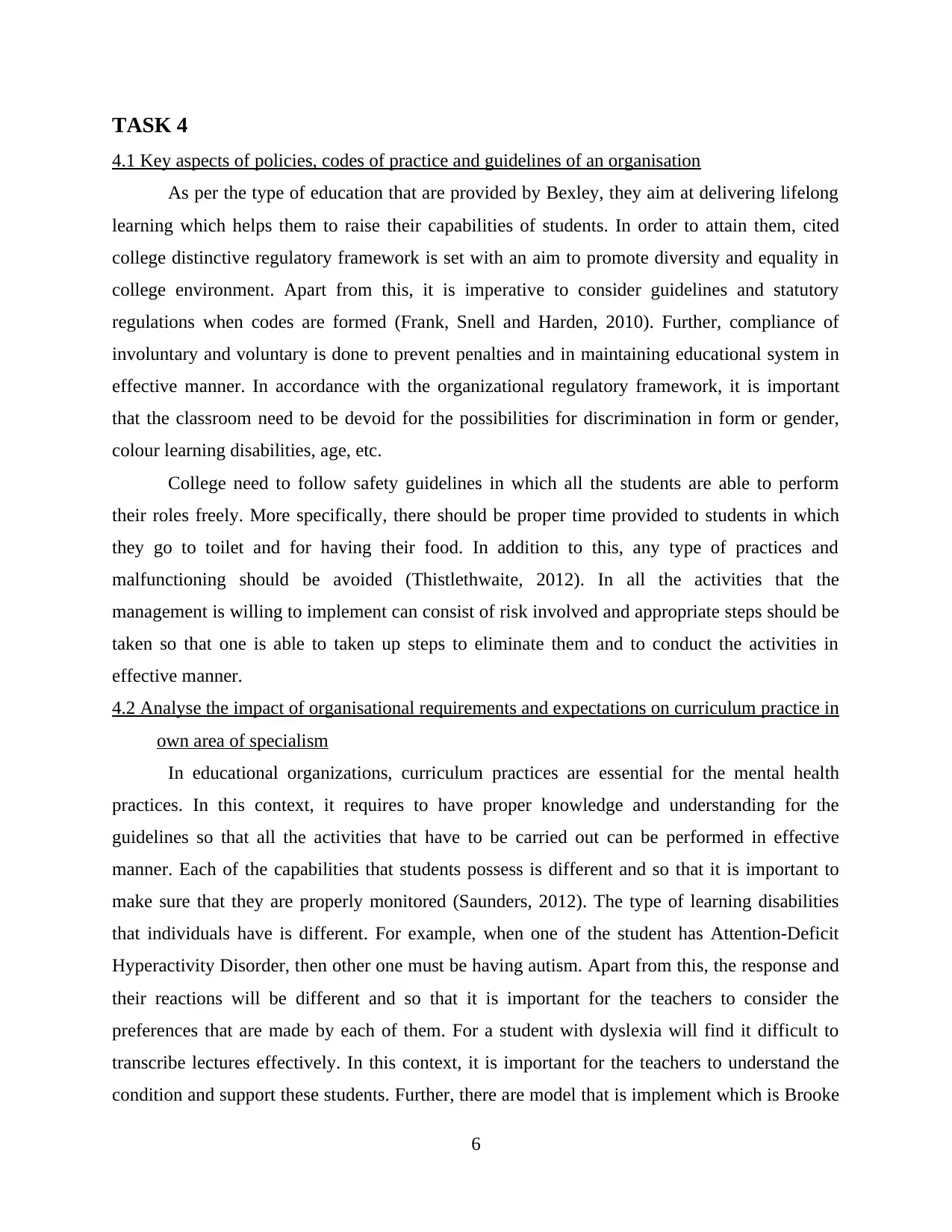
TASK 4
4.1 Key aspects of policies, codes of practice and guidelines of an organisation
As per the type of education that are provided by Bexley, they aim at delivering lifelong
learning which helps them to raise their capabilities of students. In order to attain them, cited
college distinctive regulatory framework is set with an aim to promote diversity and equality in
college environment. Apart from this, it is imperative to consider guidelines and statutory
regulations when codes are formed (Frank, Snell and Harden, 2010). Further, compliance of
involuntary and voluntary is done to prevent penalties and in maintaining educational system in
effective manner. In accordance with the organizational regulatory framework, it is important
that the classroom need to be devoid for the possibilities for discrimination in form or gender,
colour learning disabilities, age, etc.
College need to follow safety guidelines in which all the students are able to perform
their roles freely. More specifically, there should be proper time provided to students in which
they go to toilet and for having their food. In addition to this, any type of practices and
malfunctioning should be avoided (Thistlethwaite, 2012). In all the activities that the
management is willing to implement can consist of risk involved and appropriate steps should be
taken so that one is able to taken up steps to eliminate them and to conduct the activities in
effective manner.
4.2 Analyse the impact of organisational requirements and expectations on curriculum practice in
own area of specialism
In educational organizations, curriculum practices are essential for the mental health
practices. In this context, it requires to have proper knowledge and understanding for the
guidelines so that all the activities that have to be carried out can be performed in effective
manner. Each of the capabilities that students possess is different and so that it is important to
make sure that they are properly monitored (Saunders, 2012). The type of learning disabilities
that individuals have is different. For example, when one of the student has Attention-Deficit
Hyperactivity Disorder, then other one must be having autism. Apart from this, the response and
their reactions will be different and so that it is important for the teachers to consider the
preferences that are made by each of them. For a student with dyslexia will find it difficult to
transcribe lectures effectively. In this context, it is important for the teachers to understand the
condition and support these students. Further, there are model that is implement which is Brooke
6
4.1 Key aspects of policies, codes of practice and guidelines of an organisation
As per the type of education that are provided by Bexley, they aim at delivering lifelong
learning which helps them to raise their capabilities of students. In order to attain them, cited
college distinctive regulatory framework is set with an aim to promote diversity and equality in
college environment. Apart from this, it is imperative to consider guidelines and statutory
regulations when codes are formed (Frank, Snell and Harden, 2010). Further, compliance of
involuntary and voluntary is done to prevent penalties and in maintaining educational system in
effective manner. In accordance with the organizational regulatory framework, it is important
that the classroom need to be devoid for the possibilities for discrimination in form or gender,
colour learning disabilities, age, etc.
College need to follow safety guidelines in which all the students are able to perform
their roles freely. More specifically, there should be proper time provided to students in which
they go to toilet and for having their food. In addition to this, any type of practices and
malfunctioning should be avoided (Thistlethwaite, 2012). In all the activities that the
management is willing to implement can consist of risk involved and appropriate steps should be
taken so that one is able to taken up steps to eliminate them and to conduct the activities in
effective manner.
4.2 Analyse the impact of organisational requirements and expectations on curriculum practice in
own area of specialism
In educational organizations, curriculum practices are essential for the mental health
practices. In this context, it requires to have proper knowledge and understanding for the
guidelines so that all the activities that have to be carried out can be performed in effective
manner. Each of the capabilities that students possess is different and so that it is important to
make sure that they are properly monitored (Saunders, 2012). The type of learning disabilities
that individuals have is different. For example, when one of the student has Attention-Deficit
Hyperactivity Disorder, then other one must be having autism. Apart from this, the response and
their reactions will be different and so that it is important for the teachers to consider the
preferences that are made by each of them. For a student with dyslexia will find it difficult to
transcribe lectures effectively. In this context, it is important for the teachers to understand the
condition and support these students. Further, there are model that is implement which is Brooke
6
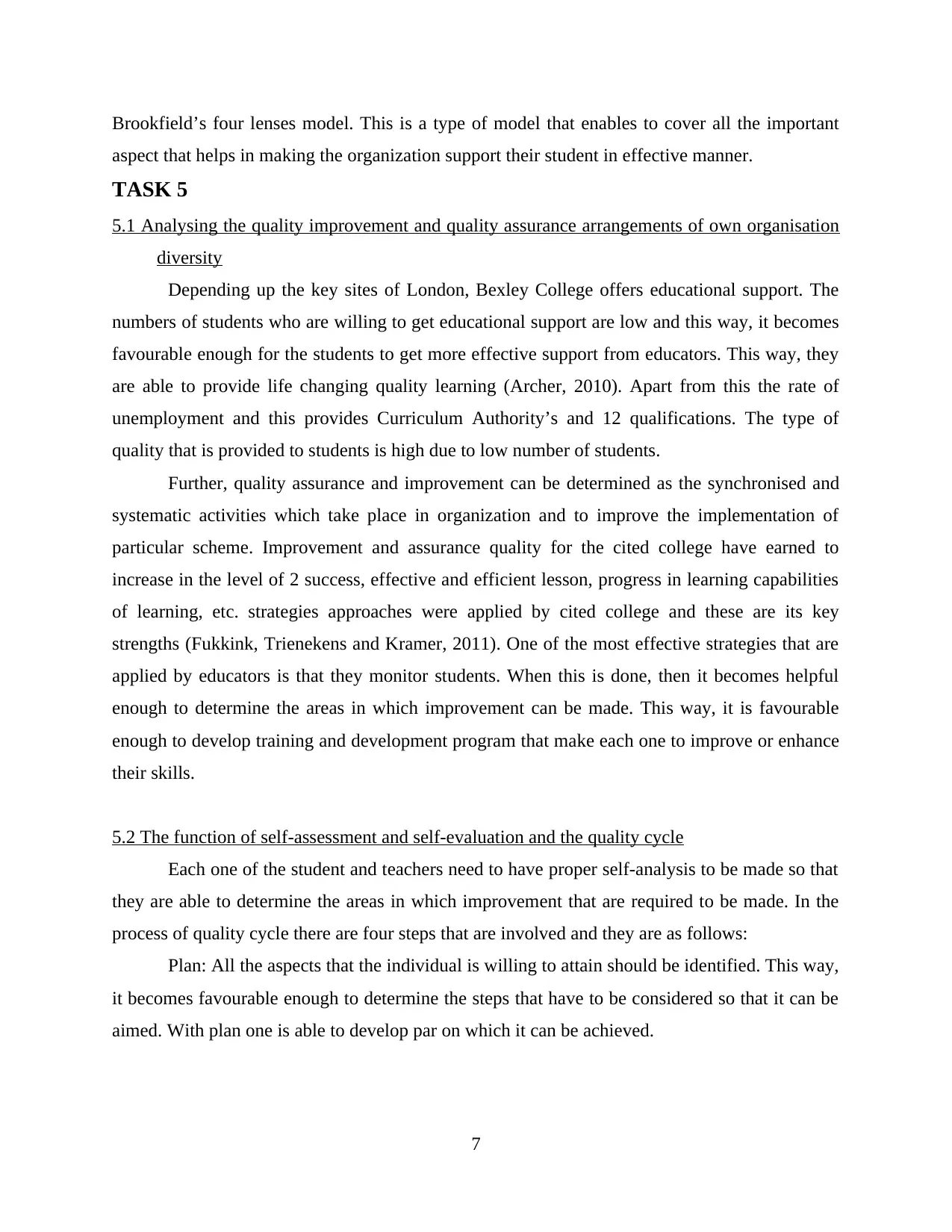
Brookfield’s four lenses model. This is a type of model that enables to cover all the important
aspect that helps in making the organization support their student in effective manner.
TASK 5
5.1 Analysing the quality improvement and quality assurance arrangements of own organisation
diversity
Depending up the key sites of London, Bexley College offers educational support. The
numbers of students who are willing to get educational support are low and this way, it becomes
favourable enough for the students to get more effective support from educators. This way, they
are able to provide life changing quality learning (Archer, 2010). Apart from this the rate of
unemployment and this provides Curriculum Authority’s and 12 qualifications. The type of
quality that is provided to students is high due to low number of students.
Further, quality assurance and improvement can be determined as the synchronised and
systematic activities which take place in organization and to improve the implementation of
particular scheme. Improvement and assurance quality for the cited college have earned to
increase in the level of 2 success, effective and efficient lesson, progress in learning capabilities
of learning, etc. strategies approaches were applied by cited college and these are its key
strengths (Fukkink, Trienekens and Kramer, 2011). One of the most effective strategies that are
applied by educators is that they monitor students. When this is done, then it becomes helpful
enough to determine the areas in which improvement can be made. This way, it is favourable
enough to develop training and development program that make each one to improve or enhance
their skills.
5.2 The function of self-assessment and self-evaluation and the quality cycle
Each one of the student and teachers need to have proper self-analysis to be made so that
they are able to determine the areas in which improvement that are required to be made. In the
process of quality cycle there are four steps that are involved and they are as follows:
Plan: All the aspects that the individual is willing to attain should be identified. This way,
it becomes favourable enough to determine the steps that have to be considered so that it can be
aimed. With plan one is able to develop par on which it can be achieved.
7
aspect that helps in making the organization support their student in effective manner.
TASK 5
5.1 Analysing the quality improvement and quality assurance arrangements of own organisation
diversity
Depending up the key sites of London, Bexley College offers educational support. The
numbers of students who are willing to get educational support are low and this way, it becomes
favourable enough for the students to get more effective support from educators. This way, they
are able to provide life changing quality learning (Archer, 2010). Apart from this the rate of
unemployment and this provides Curriculum Authority’s and 12 qualifications. The type of
quality that is provided to students is high due to low number of students.
Further, quality assurance and improvement can be determined as the synchronised and
systematic activities which take place in organization and to improve the implementation of
particular scheme. Improvement and assurance quality for the cited college have earned to
increase in the level of 2 success, effective and efficient lesson, progress in learning capabilities
of learning, etc. strategies approaches were applied by cited college and these are its key
strengths (Fukkink, Trienekens and Kramer, 2011). One of the most effective strategies that are
applied by educators is that they monitor students. When this is done, then it becomes helpful
enough to determine the areas in which improvement can be made. This way, it is favourable
enough to develop training and development program that make each one to improve or enhance
their skills.
5.2 The function of self-assessment and self-evaluation and the quality cycle
Each one of the student and teachers need to have proper self-analysis to be made so that
they are able to determine the areas in which improvement that are required to be made. In the
process of quality cycle there are four steps that are involved and they are as follows:
Plan: All the aspects that the individual is willing to attain should be identified. This way,
it becomes favourable enough to determine the steps that have to be considered so that it can be
aimed. With plan one is able to develop par on which it can be achieved.
7
⊘ This is a preview!⊘
Do you want full access?
Subscribe today to unlock all pages.

Trusted by 1+ million students worldwide
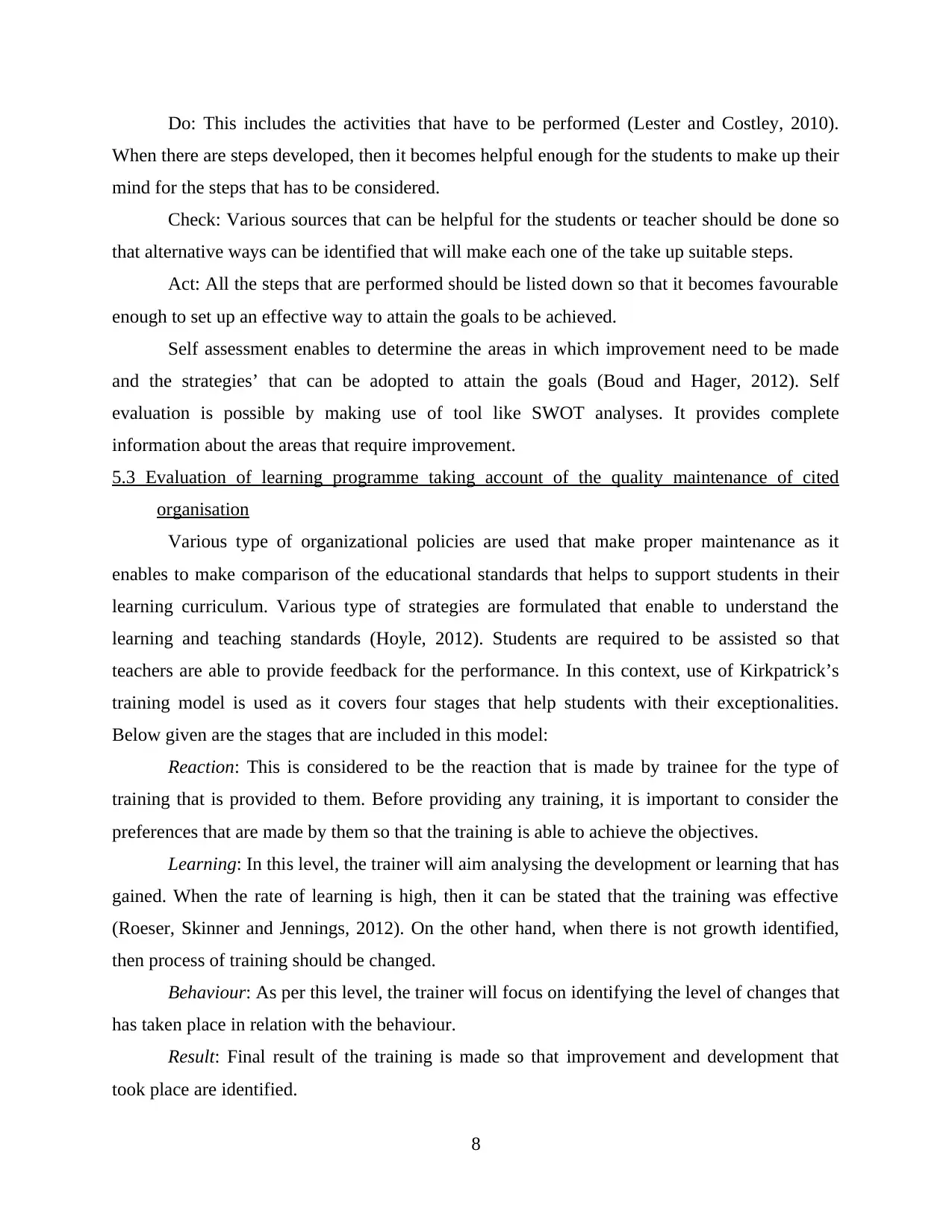
Do: This includes the activities that have to be performed (Lester and Costley, 2010).
When there are steps developed, then it becomes helpful enough for the students to make up their
mind for the steps that has to be considered.
Check: Various sources that can be helpful for the students or teacher should be done so
that alternative ways can be identified that will make each one of the take up suitable steps.
Act: All the steps that are performed should be listed down so that it becomes favourable
enough to set up an effective way to attain the goals to be achieved.
Self assessment enables to determine the areas in which improvement need to be made
and the strategies’ that can be adopted to attain the goals (Boud and Hager, 2012). Self
evaluation is possible by making use of tool like SWOT analyses. It provides complete
information about the areas that require improvement.
5.3 Evaluation of learning programme taking account of the quality maintenance of cited
organisation
Various type of organizational policies are used that make proper maintenance as it
enables to make comparison of the educational standards that helps to support students in their
learning curriculum. Various type of strategies are formulated that enable to understand the
learning and teaching standards (Hoyle, 2012). Students are required to be assisted so that
teachers are able to provide feedback for the performance. In this context, use of Kirkpatrick’s
training model is used as it covers four stages that help students with their exceptionalities.
Below given are the stages that are included in this model:
Reaction: This is considered to be the reaction that is made by trainee for the type of
training that is provided to them. Before providing any training, it is important to consider the
preferences that are made by them so that the training is able to achieve the objectives.
Learning: In this level, the trainer will aim analysing the development or learning that has
gained. When the rate of learning is high, then it can be stated that the training was effective
(Roeser, Skinner and Jennings, 2012). On the other hand, when there is not growth identified,
then process of training should be changed.
Behaviour: As per this level, the trainer will focus on identifying the level of changes that
has taken place in relation with the behaviour.
Result: Final result of the training is made so that improvement and development that
took place are identified.
8
When there are steps developed, then it becomes helpful enough for the students to make up their
mind for the steps that has to be considered.
Check: Various sources that can be helpful for the students or teacher should be done so
that alternative ways can be identified that will make each one of the take up suitable steps.
Act: All the steps that are performed should be listed down so that it becomes favourable
enough to set up an effective way to attain the goals to be achieved.
Self assessment enables to determine the areas in which improvement need to be made
and the strategies’ that can be adopted to attain the goals (Boud and Hager, 2012). Self
evaluation is possible by making use of tool like SWOT analyses. It provides complete
information about the areas that require improvement.
5.3 Evaluation of learning programme taking account of the quality maintenance of cited
organisation
Various type of organizational policies are used that make proper maintenance as it
enables to make comparison of the educational standards that helps to support students in their
learning curriculum. Various type of strategies are formulated that enable to understand the
learning and teaching standards (Hoyle, 2012). Students are required to be assisted so that
teachers are able to provide feedback for the performance. In this context, use of Kirkpatrick’s
training model is used as it covers four stages that help students with their exceptionalities.
Below given are the stages that are included in this model:
Reaction: This is considered to be the reaction that is made by trainee for the type of
training that is provided to them. Before providing any training, it is important to consider the
preferences that are made by them so that the training is able to achieve the objectives.
Learning: In this level, the trainer will aim analysing the development or learning that has
gained. When the rate of learning is high, then it can be stated that the training was effective
(Roeser, Skinner and Jennings, 2012). On the other hand, when there is not growth identified,
then process of training should be changed.
Behaviour: As per this level, the trainer will focus on identifying the level of changes that
has taken place in relation with the behaviour.
Result: Final result of the training is made so that improvement and development that
took place are identified.
8
Paraphrase This Document
Need a fresh take? Get an instant paraphrase of this document with our AI Paraphraser
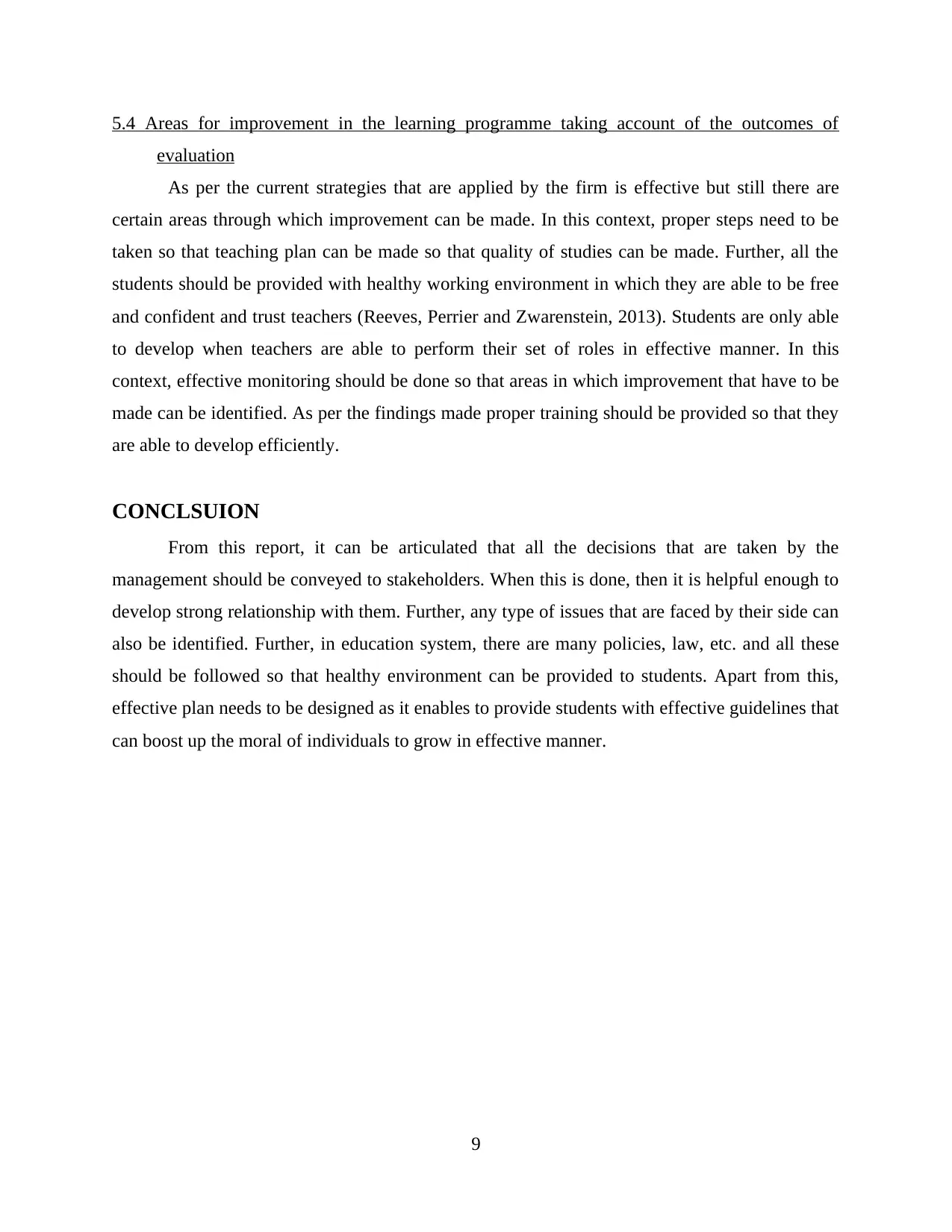
5.4 Areas for improvement in the learning programme taking account of the outcomes of
evaluation
As per the current strategies that are applied by the firm is effective but still there are
certain areas through which improvement can be made. In this context, proper steps need to be
taken so that teaching plan can be made so that quality of studies can be made. Further, all the
students should be provided with healthy working environment in which they are able to be free
and confident and trust teachers (Reeves, Perrier and Zwarenstein, 2013). Students are only able
to develop when teachers are able to perform their set of roles in effective manner. In this
context, effective monitoring should be done so that areas in which improvement that have to be
made can be identified. As per the findings made proper training should be provided so that they
are able to develop efficiently.
CONCLSUION
From this report, it can be articulated that all the decisions that are taken by the
management should be conveyed to stakeholders. When this is done, then it is helpful enough to
develop strong relationship with them. Further, any type of issues that are faced by their side can
also be identified. Further, in education system, there are many policies, law, etc. and all these
should be followed so that healthy environment can be provided to students. Apart from this,
effective plan needs to be designed as it enables to provide students with effective guidelines that
can boost up the moral of individuals to grow in effective manner.
9
evaluation
As per the current strategies that are applied by the firm is effective but still there are
certain areas through which improvement can be made. In this context, proper steps need to be
taken so that teaching plan can be made so that quality of studies can be made. Further, all the
students should be provided with healthy working environment in which they are able to be free
and confident and trust teachers (Reeves, Perrier and Zwarenstein, 2013). Students are only able
to develop when teachers are able to perform their set of roles in effective manner. In this
context, effective monitoring should be done so that areas in which improvement that have to be
made can be identified. As per the findings made proper training should be provided so that they
are able to develop efficiently.
CONCLSUION
From this report, it can be articulated that all the decisions that are taken by the
management should be conveyed to stakeholders. When this is done, then it is helpful enough to
develop strong relationship with them. Further, any type of issues that are faced by their side can
also be identified. Further, in education system, there are many policies, law, etc. and all these
should be followed so that healthy environment can be provided to students. Apart from this,
effective plan needs to be designed as it enables to provide students with effective guidelines that
can boost up the moral of individuals to grow in effective manner.
9
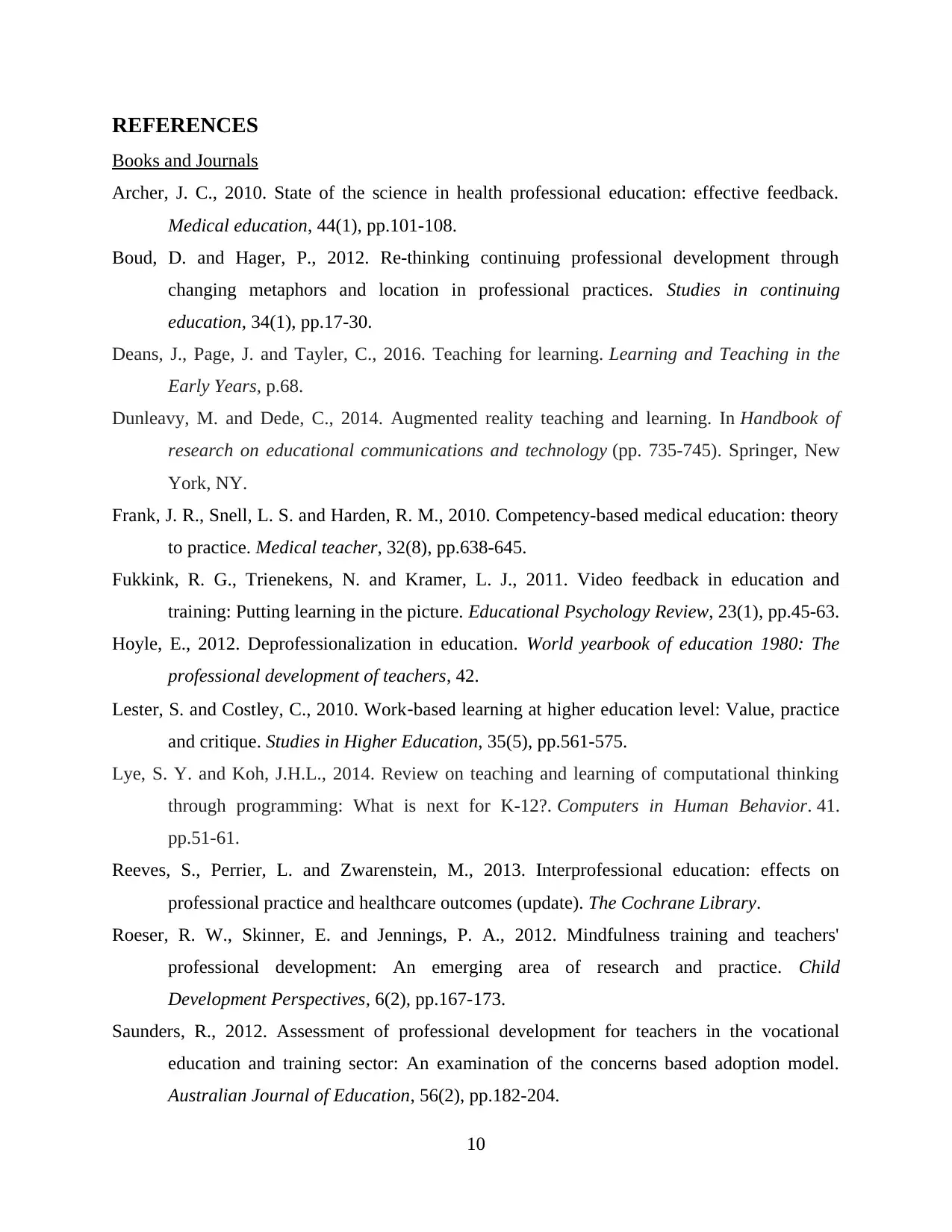
REFERENCES
Books and Journals
Archer, J. C., 2010. State of the science in health professional education: effective feedback.
Medical education, 44(1), pp.101-108.
Boud, D. and Hager, P., 2012. Re-thinking continuing professional development through
changing metaphors and location in professional practices. Studies in continuing
education, 34(1), pp.17-30.
Deans, J., Page, J. and Tayler, C., 2016. Teaching for learning. Learning and Teaching in the
Early Years, p.68.
Dunleavy, M. and Dede, C., 2014. Augmented reality teaching and learning. In Handbook of
research on educational communications and technology (pp. 735-745). Springer, New
York, NY.
Frank, J. R., Snell, L. S. and Harden, R. M., 2010. Competency-based medical education: theory
to practice. Medical teacher, 32(8), pp.638-645.
Fukkink, R. G., Trienekens, N. and Kramer, L. J., 2011. Video feedback in education and
training: Putting learning in the picture. Educational Psychology Review, 23(1), pp.45-63.
Hoyle, E., 2012. Deprofessionalization in education. World yearbook of education 1980: The
professional development of teachers, 42.
Lester, S. and Costley, C., 2010. Work‐based learning at higher education level: Value, practice
and critique. Studies in Higher Education, 35(5), pp.561-575.
Lye, S. Y. and Koh, J.H.L., 2014. Review on teaching and learning of computational thinking
through programming: What is next for K-12?. Computers in Human Behavior. 41.
pp.51-61.
Reeves, S., Perrier, L. and Zwarenstein, M., 2013. Interprofessional education: effects on
professional practice and healthcare outcomes (update). The Cochrane Library.
Roeser, R. W., Skinner, E. and Jennings, P. A., 2012. Mindfulness training and teachers'
professional development: An emerging area of research and practice. Child
Development Perspectives, 6(2), pp.167-173.
Saunders, R., 2012. Assessment of professional development for teachers in the vocational
education and training sector: An examination of the concerns based adoption model.
Australian Journal of Education, 56(2), pp.182-204.
10
Books and Journals
Archer, J. C., 2010. State of the science in health professional education: effective feedback.
Medical education, 44(1), pp.101-108.
Boud, D. and Hager, P., 2012. Re-thinking continuing professional development through
changing metaphors and location in professional practices. Studies in continuing
education, 34(1), pp.17-30.
Deans, J., Page, J. and Tayler, C., 2016. Teaching for learning. Learning and Teaching in the
Early Years, p.68.
Dunleavy, M. and Dede, C., 2014. Augmented reality teaching and learning. In Handbook of
research on educational communications and technology (pp. 735-745). Springer, New
York, NY.
Frank, J. R., Snell, L. S. and Harden, R. M., 2010. Competency-based medical education: theory
to practice. Medical teacher, 32(8), pp.638-645.
Fukkink, R. G., Trienekens, N. and Kramer, L. J., 2011. Video feedback in education and
training: Putting learning in the picture. Educational Psychology Review, 23(1), pp.45-63.
Hoyle, E., 2012. Deprofessionalization in education. World yearbook of education 1980: The
professional development of teachers, 42.
Lester, S. and Costley, C., 2010. Work‐based learning at higher education level: Value, practice
and critique. Studies in Higher Education, 35(5), pp.561-575.
Lye, S. Y. and Koh, J.H.L., 2014. Review on teaching and learning of computational thinking
through programming: What is next for K-12?. Computers in Human Behavior. 41.
pp.51-61.
Reeves, S., Perrier, L. and Zwarenstein, M., 2013. Interprofessional education: effects on
professional practice and healthcare outcomes (update). The Cochrane Library.
Roeser, R. W., Skinner, E. and Jennings, P. A., 2012. Mindfulness training and teachers'
professional development: An emerging area of research and practice. Child
Development Perspectives, 6(2), pp.167-173.
Saunders, R., 2012. Assessment of professional development for teachers in the vocational
education and training sector: An examination of the concerns based adoption model.
Australian Journal of Education, 56(2), pp.182-204.
10
⊘ This is a preview!⊘
Do you want full access?
Subscribe today to unlock all pages.

Trusted by 1+ million students worldwide
1 out of 13
Related Documents
Your All-in-One AI-Powered Toolkit for Academic Success.
+13062052269
info@desklib.com
Available 24*7 on WhatsApp / Email
![[object Object]](/_next/static/media/star-bottom.7253800d.svg)
Unlock your academic potential
Copyright © 2020–2025 A2Z Services. All Rights Reserved. Developed and managed by ZUCOL.


